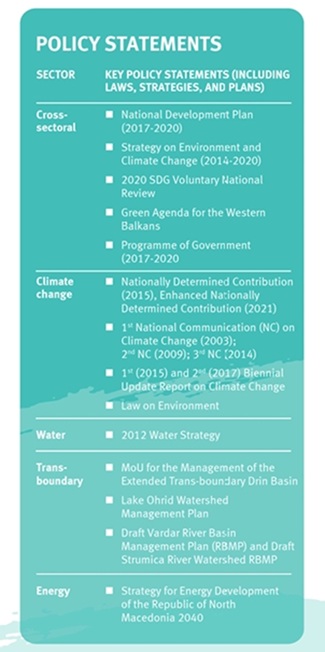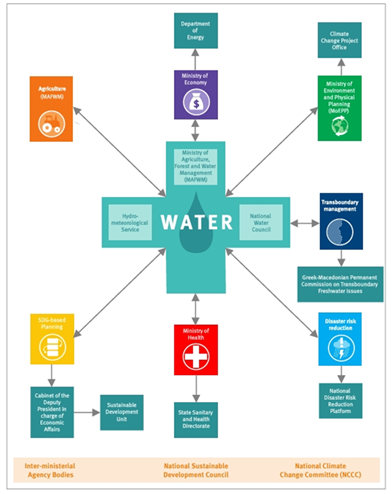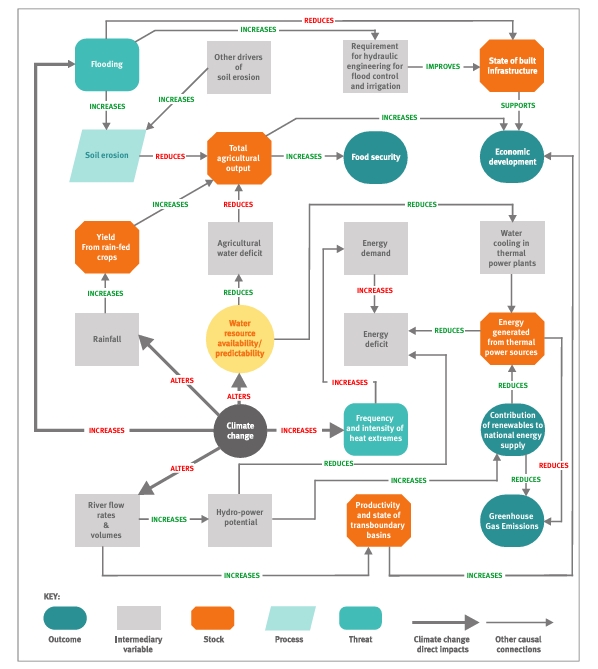In North Macedonia, where the terrain is characterized by frequent transitions between mountains, basins, and valleys, flash floods in urban areas present a serious threat, especially considering the current climate change and its effects. Climate change, as a global phenomenon, is characterized by an increase in average temperatures worldwide. Global warming, in turn, affects weather conditions, especially the frequency of extreme weather events (heat waves, extreme precipitation, storms)
Which areas in North Macedonia are most at risk?
 National latest research shows that 63.6% of the watersheds in North Macedonia are prone to flash floods. Smaller watersheds of rivers such as Treska River Basin, Kriva Reka River Basin, Pčinja River Basin, Bregalnica River Basin, Pena River Basin, Crna Reka River Basin, Strumica River Basin and Vardar River Basin are the most vulnerable in terms of high and very high flash flood potential, with a history of flooding events. Notable flood events include those in the Treska River Basin in 2010 and 2021, in the Kriva Reka River Basin in 2004, 2005, 2010, 2013, 2014, and floods in the Pčinja River Basin in 2010. The Vardar River Basin has also faced flash floods, with recent events occurring in 2016, 2020, 2021, and 2023.
National latest research shows that 63.6% of the watersheds in North Macedonia are prone to flash floods. Smaller watersheds of rivers such as Treska River Basin, Kriva Reka River Basin, Pčinja River Basin, Bregalnica River Basin, Pena River Basin, Crna Reka River Basin, Strumica River Basin and Vardar River Basin are the most vulnerable in terms of high and very high flash flood potential, with a history of flooding events. Notable flood events include those in the Treska River Basin in 2010 and 2021, in the Kriva Reka River Basin in 2004, 2005, 2010, 2013, 2014, and floods in the Pčinja River Basin in 2010. The Vardar River Basin has also faced flash floods, with recent events occurring in 2016, 2020, 2021, and 2023.
The country’s flood prevention includes an integrated approach, along with the climate adaptation strategies and the modernization of infrastructure for flood prevention and management.
A Historical Perspective on Flood Risk Legislation
 North Macedonia’s flood risk legislation has evolved significantly through alignment with the EU Floods Directive (2007/60/EC), which emphasizes risk assessment, mapping, and management plans. Historically, the country’s framework relied on national laws like the Law on Waters and Protection and Rescue Law, but EU accession efforts since the early 2010s drove reforms to adopt the directive’s three-phase approach: Preliminary Flood Risk Assessments (PFRAs), Flood Hazard and Risk Mapping (FHRM), and Flood Risk Management Plans (FRMPs). Key milestones include the National Water Strategy (2012–2042), which integrated EU principles, and the development of FRMPs for major basins like Strumica and Kumanovo with UNDP and EU support. Despite progress, challenges persist, including fragmented institutional responsibilities and delayed implementation of nature-based solutions.
North Macedonia’s flood risk legislation has evolved significantly through alignment with the EU Floods Directive (2007/60/EC), which emphasizes risk assessment, mapping, and management plans. Historically, the country’s framework relied on national laws like the Law on Waters and Protection and Rescue Law, but EU accession efforts since the early 2010s drove reforms to adopt the directive’s three-phase approach: Preliminary Flood Risk Assessments (PFRAs), Flood Hazard and Risk Mapping (FHRM), and Flood Risk Management Plans (FRMPs). Key milestones include the National Water Strategy (2012–2042), which integrated EU principles, and the development of FRMPs for major basins like Strumica and Kumanovo with UNDP and EU support. Despite progress, challenges persist, including fragmented institutional responsibilities and delayed implementation of nature-based solutions.
Recent projects, such as the 2023 EU-funded initiative led by Eptisa, aim to harmonize legislation, strengthen administrative capacity, and establish early warning systems. [https://www.eptisasee.com/news/eptisa-awarded-eu-floods-directive-project-in-republic-of-north-macedonia/]. In addition to the Eptisa project, North Macedonia Ministry of Environment and Physical Planning (MoEPP) is implementing the IPA-funded project “Advancing the Implementation of the EU Floods Directive through Harmonization of National Legislation and Preparation of Flood Risk Management Plans.” [https://www.moepp.gov.mk/informacii/proekti/proekti-finansirani-ipa/unapreduvanje-implementacija-direktiva-poplavi-eu]. This project’s general goal is to increase environmental protection and safeguard human life, health, and property from the negative effects of floods by fully aligning national legislation with the EU Floods Directive and supporting its implementation. Key activities include: updating the legal framework for flood risk management, strengthening institutional capacities, conducting preliminary flood risk assessments for all ten river sub-basins, developing flood hazard and risk maps, mapping torrents and landslides, creating flood risk management plans with strategic environmental assessments, and preparing an implementation plan for a national flood early warning system.
Who Manages Water and Flood Protection?
The boundaries of river basin districts have been defined throughout the country and River Basin Management Plans (RBMPs) are in various stages of development and implementation. Completion of all river basin management plans (RBMPs) is listed as a priority from 2020 onwards. North Macedonia’s flood risk management is guided by national laws, EU directives, and international agreements to align with EU Directives.  The country is actively aligning its legislation with the EU Floods Directive (2007/60/EC), which mandates the assessment, mapping, and coordinated management of flood risks. Key national strategies include the Protection and Rescue Law, Law on Waters, and the National Water Strategy (2012–2042). Flood protection and water management are coordinated by several institutions:
The country is actively aligning its legislation with the EU Floods Directive (2007/60/EC), which mandates the assessment, mapping, and coordinated management of flood risks. Key national strategies include the Protection and Rescue Law, Law on Waters, and the National Water Strategy (2012–2042). Flood protection and water management are coordinated by several institutions:
• Ministry of Environment and Physical Planning (MoEPP): Oversees implementation of the EU Flood Directive and integrated water management.
• Protection and Rescue Directorate (PRD) & Crisis Management Centre (CMC): Responsible for disaster prevention, preparedness, and response at national and regional levels.
• Local Authorities: Develop and execute protection and rescue plans, conduct risk assessments, and manage local response teams.
Local authorities are responsible for implementing preparedness measures and communicating with the public during emergencies.
Key Gaps
Persistent issues include fragmented legal frameworks, unclear division of responsibilities, insufficient technical and financial resources, and incomplete flood risk management plans. There is also a need for better integration of climate change considerations and stakeholder participation at all levels.
What’s Next?
For North Macedonia to make significant progress in combating climate change and urban flooding, collective action is required in several key areas. These include filling legal gaps, more effective engagement and involvement of national and local stakeholders, and prioritizing climate-related activities at all levels of government. The adoption of the Climate Action Law is crucial.
North Macedonia is at a critical crossroads in its journey toward effective climate management. The adoption of the National Energy and Climate Plan (NECP) in 2022 was a positive step, but significant challenges remain, particularly in the area of legislative action and stakeholder engagement.
To address the urgent and complex challenges posed by climate change—including urban flooding—it is necessary for North Macedonia to achieve real progress. Thus, the country must push forward with legislative action, technological innovation, and community involvement. By doing so, it will not only reduce the risks of urban flooding but also create more resilient cities capable of withstanding the future challenges brought about by a changing climate.
Future Outlook and Recommendations.
 Several Policy Enhancements can be proposed.
Several Policy Enhancements can be proposed.
• Further legislative harmonization with EU directives to clarify roles and responsibilities and streamline crisis management.
• Strengthening public-private partnerships to leverage expertise and resources for flood risk reduction.
• Expanding financial mechanisms through increased access to EU and national funds for flood mitigation projects.
• Promoting nature-based solutions such as wetland restoration and green infrastructure to complement traditional engineering measures.
Strategic Actions
• Synchronize river basin management with flood risk management plans.
• Invest in modern hydrological forecasting and early warning technologies.
• Foster inter-institutional and cross-border cooperation.
• Enhance public communication and community engagement through education and drills.
• Build technical capacity and conduct regular simulation exercises for emergency response.
 English (UK)
English (UK)  Македонски
Македонски 
